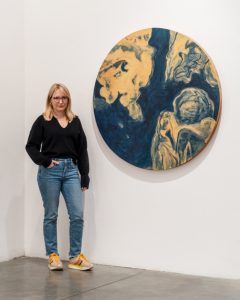Today we’re pleased to feature and interview with Los Angeles-based artist Erica Everage is a contemporary painter with a background in theatre and dance. A native Angeleno, she was born in Los Angeles and began drawing the nude figure religiously when she was just thirteen years old, and won a Los Angeles Music Center Spotlight Award in 2005 for her drawing. She was an apprentice to the late sculptor Robert Graham, and holds a BA in Theatre from Northwestern University and an MFA in Fine Art from Otis College of Art and Design.
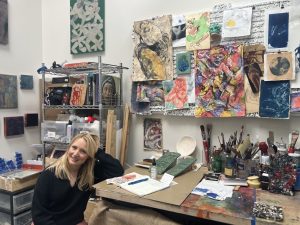
How long have you been creating art, and why did you decide to focus mainly on abstract art? What does that medium allow you to do that others don’t?
I started seriously drawing and painting in middle school, thanks to a life drawing class I took with a wonderful teacher who really encouraged me. As a painter, I work at the intersection of abstraction and figuration. I identify as a feminist artist. My work examines what it means and has meant to inhabit a woman’s body moving through space(s), time, and histories. Abstraction allows me to fully push the medium of painting. It also is well suited to the improvisational and intuitive elements of my process. “Mistakes” become gold. By abstracting the source images in my head and archive, I allow the paintings to be read in multiple ways; they are in flux and can mean different things to different people.
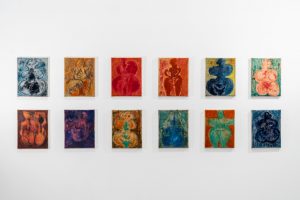
What is your artistic process, and how has it changed since you started?
I take inspiration from a wide variety of sources: paleolithic cave paintings, Neolithic goddess iconography, fringe biblical stories and ancient mythology, feminist discourses, aging architecture, graffitied walls, etc. As a very young artist, I was solely focused on the human body. Now, my work is more conceptual and more abstract.
You also make dance paintings, based on your own dancing. Can you tell us about how you got into dance paintings, how you create them, and what the connection is for you between dance and painting?
Yes! So, I used to be a student (and then teacher) of erotic pole dance. It was a life-changing experience for me, as a survivor of sexual assault who lived with a lot of shame in her body. Through this dance practice, I was able to immerse my brain in my body and tap into energies and sensations I never knew existed in me before. The dance practice is not choreography or routine based; it is a body-led, emotional, sensual, soulful, erotically empowered world of movement.
About a year and a half ago, the thought occurred to me to film myself while dancing, and then paint the dance in some way. So I pinned up long panels of cardboard to the studio walls, like a long frieze, and began to loosely interpret the video of my dance with the paintbrush, painting as the video played in slow motion. This experiment opened a whole new chapter up for me. In addition to the dance frieze paintings (which are long and horizontal) I now also take stills of my dance videos and turn those frozen moments into paintings that center on just one gesture, as opposed to a flowing parade of body movement.
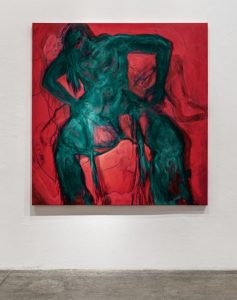
You write on your website that you resurrect “overlooked or misunderstood ancient goddesses and obscure mythological characters – such as Lilith, Baubo, Sheela-na-gigs and Neolithic Venuses.” and “imaginatively travel[s] back in time to a world before patriarchy and misogyny, where feminine deities were worshipped.” Why is that so meaningful to you and how you’ve made those interests part of your art?
I find historical occlusion very interesting, especially as it pertains to the occlusion of women’s power and stories. I only learned a few months ago for instance, that the first known author was a woman. She’s the first author (that we know of) whose name is signed to her writing. She lived in Ancient Mesopotamia and was a priestess who worshipped the feminine deity Inanna. Considering that in the culture I’ve grown up in, women are often treated like objects (vessels for birth, sex objects, etc.) I find it interesting to learn about a time and place (Neolithic European societies) where people envisioned their creator as a feminine creature. This primal creative energy that brought life to the earth was thought of as feminine, as opposed to masculine. Instead of the old bearded man in the sky whom I was brought up with, other people have looked to the Earth and the feminine for direction and safety, and I think that’s beautiful. I personally do not practice any religion and I consider myself agnostic, but I like to research and honor all sorts of possibilities.
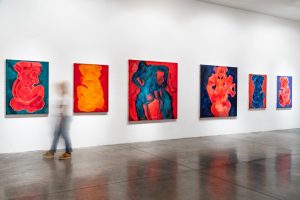
Is there a message you hope viewers take away from your art?
A couple of women told me that being surrounded by my paintings at my thesis show, DIVINE HAG, gave them a bodily sense of feeling safe and empowered. I was so honored and moved to hear that, and I hope that happens again and again when people encounter my artwork.
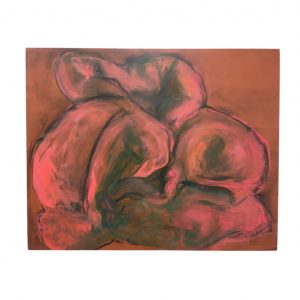
Which pieces or types of pieces have been most popular and why do you think that is?
It’s hard to say really. Some people are really drawn to the paintings where you can see a figure in an empowered gesture while others are drawn to the more abstract pieces that can be enjoyed more for their sense of movement.
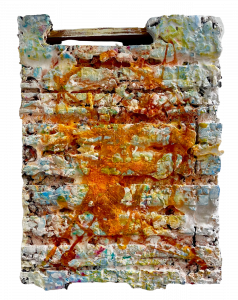
Who’s an artist or a few artists whose art you admire, and why?
Tracey Emin for her unapologetic drippy gestural guttural mark-making. Nancy Spero for her expansive, researched feminist works (love her piece Notes in Time, 1979, at MOMA) (She was a fellow fan of the Sheela-na-gig and Baubo). Cecily Brown’s colors and movement. Jennifer Packer’s everything (I could look at her paintings for hours). Trulee Hall’s playfully erotic, shame-free world-building. (She’s also inspired by the Lilith story!)
What are your plans for the future of your art?
To keep painting, keep showing, keep learning and expanding! I want to travel to Ireland to see the Sheela-na-gigs in person and to Malta to see the Ggantija temples and the hypogeum and all those Neolithic femme icons formerly known as Venuses! I also want to see some Baubo sculptures figurines in person. I hope to ultimately be a professor of art in the future while maintaining a studio practice and showing at galleries regularly.
